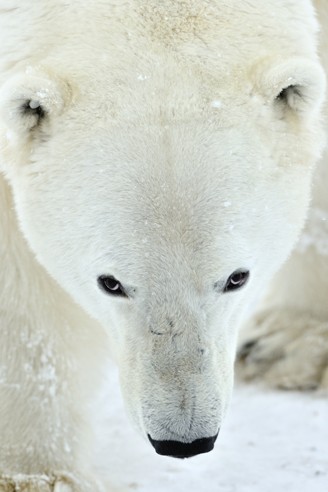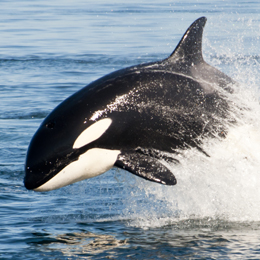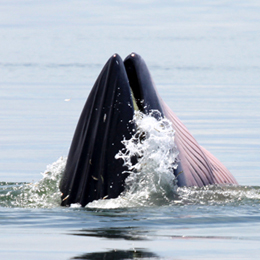Description
Polar bears have many different names such as Sea Bear, Ice Bear, Lord of the Arctic, and White Sea Deer. In 1774, Constantine John Phipps was the first to describe the polar bear as a different species. The chosen scientific name, Ursus maritimus literally means ‘maritime bear’.
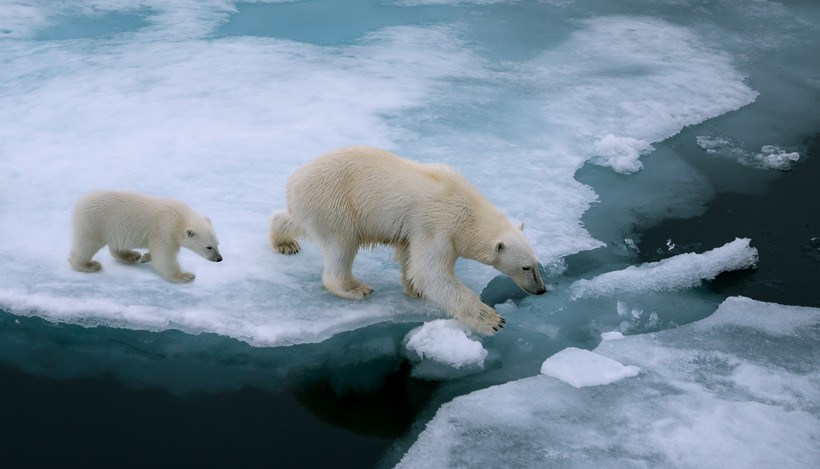
Mother polar bear and cub walking on ice, arctic ocean (svalbard, Norway)
?
Image credits: FloridaStock/Shutterstock
The Kodiak bear, a subspecies of the brown bear, is said to be the only bear that is similar to polar bears in size. Average adult polar bears (body including head) measure around 8 ft (2.5 m). The tail is around 5 in (12.5 cm) and they weigh around 1,600 lbs (720 kg).
They are the second most sexually dimorphic mammals, directly after the pinnipeds. This means that there is a significant difference in size between male and female polar bear. Male polar bears can grow up to an average size of 8-10 ft (2.5-3 m) as compared to adult female polar bears that show an average size of 6-8 ft (1.8-2.5 m). This size difference becomes more prominent in their average weight. Adult males may weigh up to 550-1700 lbs (250-770 kg) whereas adult sows may weigh up to 330-650 lbs (150-294 kg). The differences do not end at the size and weight. Both the sexes display extremely different patterns in their behavior. The sole responsibility of nurturing and protecting the cubs is on females. Males, once the mating is over, leave their female counterparts to pursue other activities.
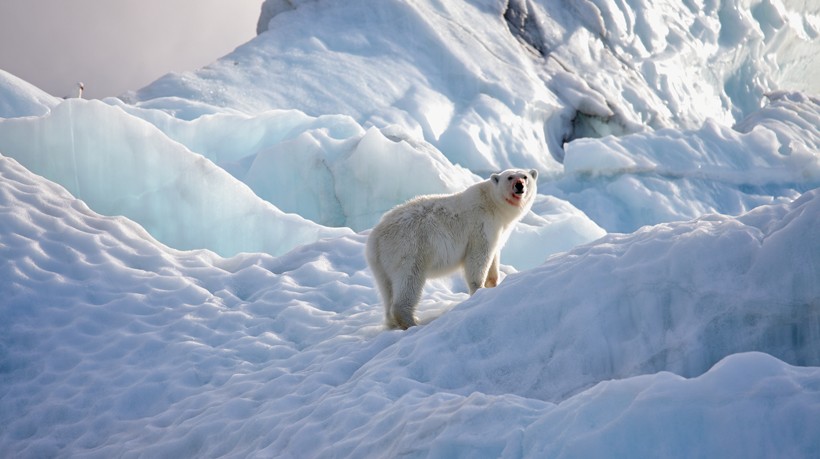
Polar bear standing on arctic ice floes
?
Image credits: Vladimir Melnik/Shutterstock
The polar bear has a highly developed sense of smell that supports to locate prey from a distance of over a mile (1.6 km). They can also detect their prey buried under the snow of more than one meter (3 ft). The sense of hearing of the polar bear is as good as that of human beings and with the help of their excellent vision polar bears can clearly see things from a far distance.
Polar Bears Vs. Brown Bears
Brown bears are the closest relatives of polar bears. They both belong to the same genus, Ursus, but differ in species; the polar bear belongs to the U. maritimus species while brown bears belong to the U. arctos species. Polar bears are native to the Arctic Circle and its surrounding areas whereas brown bears live in Asia, Northern Europe and North America. The most evident difference between the two mammals is the color of their fur. While polar bears have white to yellow coats, brown bears are silvery-brown. The more elongated bodies and longer skulls of polar bears also differentiate them from brown bears. In terms of size, polar bears are larger than the brown bears with the exception of Kodiak bears. The feet of polar bears have soft papillae paws and are much larger than that of brown bears. On the other hand, the claws of brown bears are large and curved whereas polar bears show small claws.
Brown bears are not as good long distance swimmers as their polar region counterparts. Additionally, polar bears are absolute carnivores as opposed to brown bears that are omnivores. Ursus arctos are typically nocturnal animals. For polar bears, night and day are of little relevance in living within the Arctic Circle. Whereas a strong sense of territory is observed among brown bears, polar bears are not territorial at al.
Anatomy and Characteristics
Polar bears have slender bodies and long necks. They have a relatively small head (as compared to their bodies) with elongated snouts and small ears that enable them to conserve energy.
The most striking feature of polar bears is their snowy coat. The white coat gradually turns yellow as they mature. The thick coat consists of insulated fur and a layer of fat to keep them warm in one of the coldest environments on the planet. The white fur also provides camouflage in the snow and on the ice. However, polar bears have a black skin under their white fur. The advantage of this black skin is that it better absorbs the sun rays.
The hind limbs of polar bears are longer than the forelimbs, making the hind end stand taller than their shoulders. They have fur on the lower part of the five-toed paws, protecting them from the ice-cold underground and assuring a good grip on the slippery ice. The large paws act as snowshoes and balance the weight of polar bears while walking or running on the ice. The wide front paws are webbed to facilitate swimming. The curved, non-retractile claws on toes are used to grasp the prey and also for traction while moving on ice.
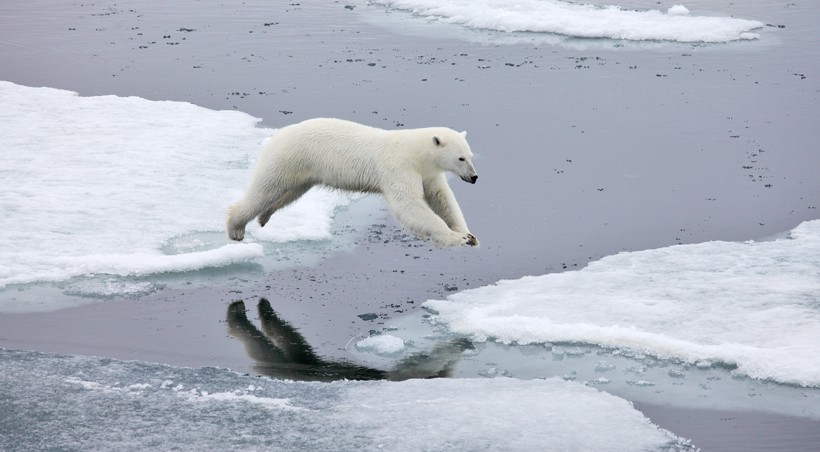
The hind limbs of polar bears are longer than the forelimbs, making the hind end stand taller than their shoulders.
?
Image credits: Vladimir Melnik/Shutterstock
The highly carnivorous diet of polar bears requires strong teeth. Of their 42 teeth, the cheek teeth are smaller while the canines are larger as well as sharper. Most of the food is swallowed instead of chewed.
Habitat
As marine mammals, polar bears spend a major part of the year in water. They are the only living marine mammal that have large, strong limbs and feet to help them walk and run on land. The preferred landscape of polar bears is sea ice that covers the Arctic sea between different island groups and continental shelf waters. Sea ice is formed when water in the sea freezes. These preferred areas are highly biologically productive and are better suited for polar bears than the deep Arctic waters. The cuddly creatures can walk for miles and often visit the polynyas (areas where water meets sea ice). They also frequently visit the stretches of open water temporarily formed on the Arctic ice. Their favorite habitat is also the home of seals that make up the major part of the polar bears' diet.
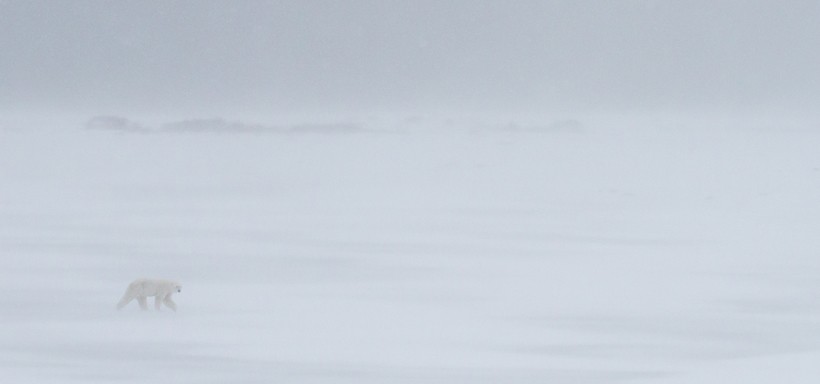
Polar bear walking through an ice blizzard
?
Image credits: TheGreenMan/Shutterstock
Due to weather changes, the open water sites in these areas appear and disappear around the year. This forces seals to migrate, followed by the polar bears. During summer when the ice is melting, polar bears migrate to land area, patiently waiting for the next freezing season. The ice towards the north remains frozen throughout the year, attracting polar bears each summer. These beautiful mammals are found throughout the Arctic regions including Canada, Alaska (The United States), Russia, Norway, and Greenland.
Diet and Hunting skills
The common phrase - "Looks can be deceiving" is the perfect fit for polar bears. They look adorable and harmless in their pristine white, furry coat. However, don't let their appearance mislead you as they are one of the largest carnivores of the polar region.
The primary diet of polar bears consists of seals. Millions of seals can be found in the Arctic. They are preyed upon when coming out their holes on the ice for breathing. In particular, the hunting occurs on the boundary of open water and ice.
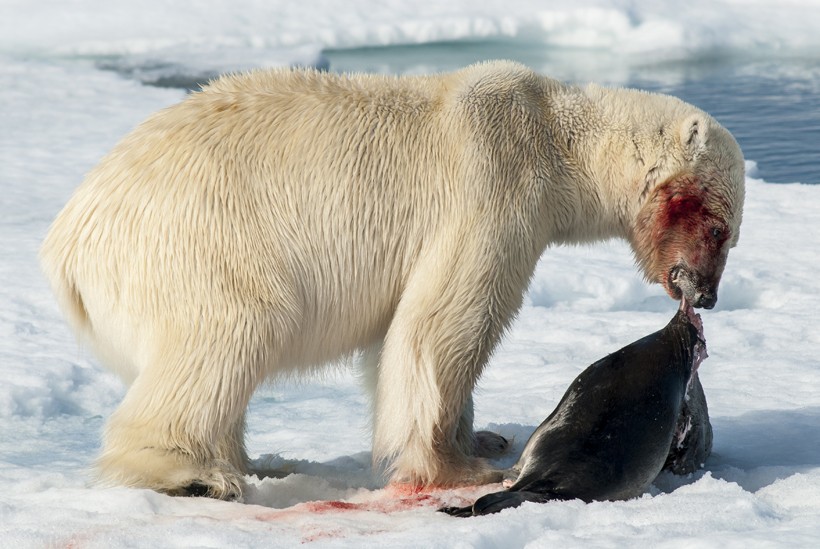
The primary diet of polar bears consists of seals.
?
Image credits: vladsilver/Shutterstock
50% of the polar bears’ time is spent while hunting for food. The success rate of their hunting is only 2%. Still-hunting is the most common method of hunting used by polar bears. The mammals use their strong sense of smell to locate their prey. They patiently crouch and wait till their prey leaves the shelter, which may lasting hours. When the seals come out to breathe, the polar bears smell their breath and attack. They drag the seals to open area and kill them by biting and crushing the skull.
An alternative way of hunting seals is by spotting and crouching nearby resting seals. When unnoticed, they creep nearby and attack. Polar bears also attack the birth lairs created by female seals.
Seals offer an energy-rich diet for especially hungry mothers and their growing cubs. Where the calorie-rich blubber and skin is consumed by the mother, the protein-rich red meat is left for the young ones.
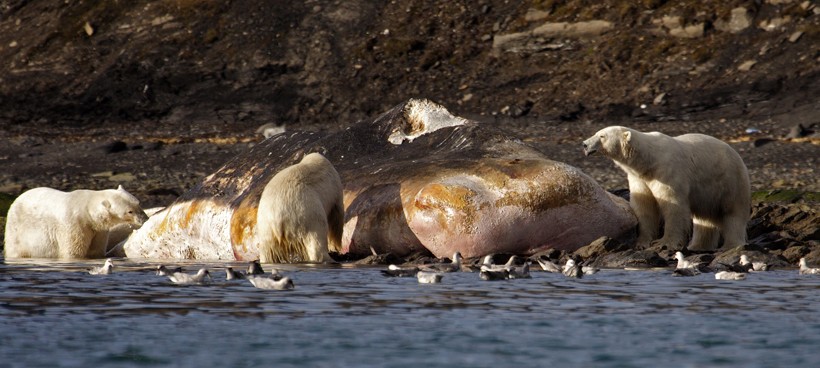
Polar bears feeding on a dead sperm whale
?
Image credits: Gail Johnson/Shutterstock
The life of a polar bear shows a feasting and fasting cycle. These large carnivores devour huge amounts of seals when the food is in abundance. They build fat reserves between April and July each year. These reserves are used to survive the food-free seasons that can last 3-4 months. Unfortunately, nowadays the polar bears have to wait longer for the hunting season as there is a delay in the formation of ice packs due to climate change. Polar bears may travel thousands of miles in search of food.
Mature polar bears eat only the fat of seals and leave the carcass for scavengers such as ravens and foxes. It is believed that polar bears also eat birds, bird eggs, reindeer, walrus, rodents, beluga whales, and crustaceans.
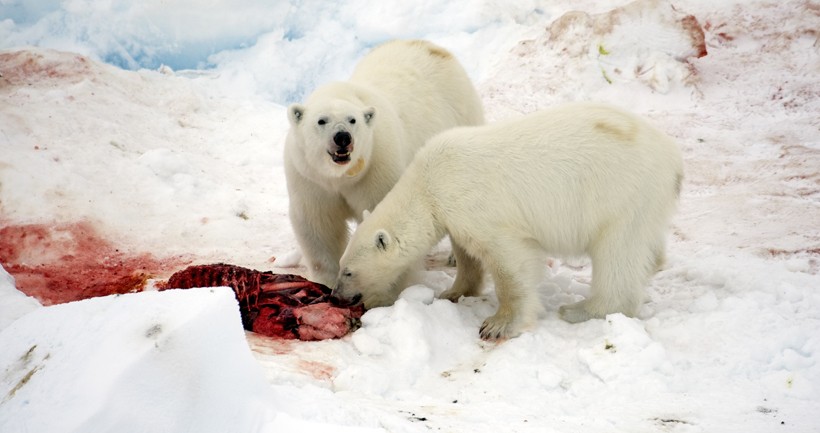
The polar bear is ready to share food with other bears if they beg properly.
?
Image credits: BMJ/Shutterstock
An intriguing observation is their eating etiquette to share food when a prey is killed by one bear. This polar bear is ready to share the food with other bears if they beg properly. The begging gestures involve submissive approach, slowly circling around the carcass and touching the nose of the bear who killed the prey.
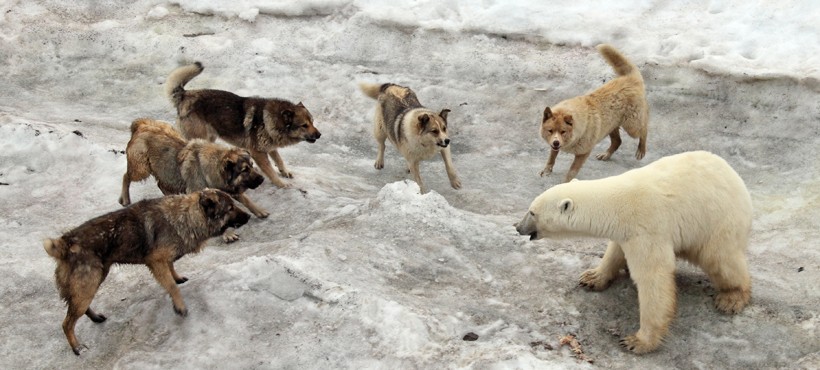
Rare sight of dogs attacking a polar bear
?
Image credits: Vladimir Melnik/Shutterstock
These great predators are at the top of the food chain in the Arctic. Therefore, they don't have many enemies. However, the cubs may be attacked by wolves or other, malnourished polar bears.
Reproduction and Life Cycle
Male polar bears attain sexual maturity around 6 years of age while females start to breed approximately 4 years after birth. Polar bears have a polygynous mating system. In April and May, they court and mate on the sea ice. Breeding females are followed by males for about 61 miles (100 km), as being attracted by the scent of the females. For the right to mate, males fight intensively with each other. These fights result often in broken teeth and deep scars. The winner stays with the breeding female while repeatedly mating for another week and leading to ovulation at the females.
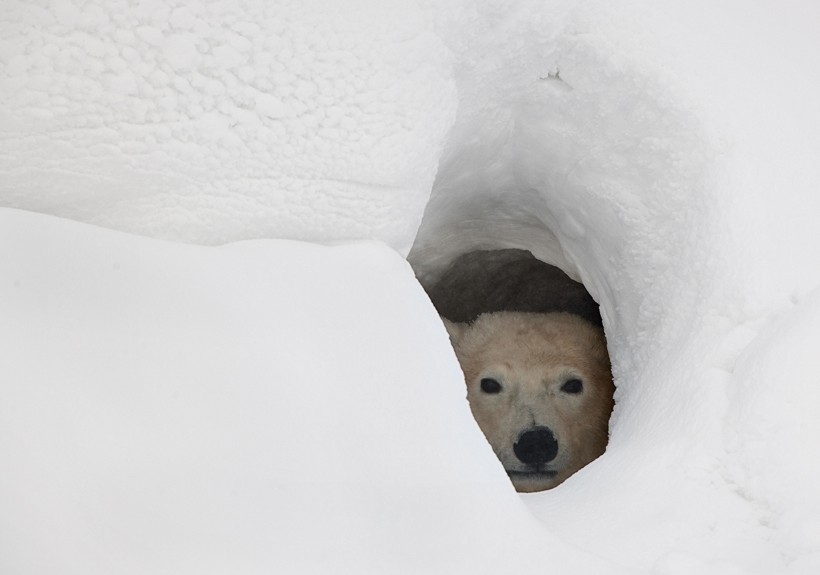
Pregnant polar bear hibernating in a deep den
?
Image credits: Sergey Uryadnikov/Shutterstock
Once the egg is fertilized, it does not get implanted until August or September. During this period, the pregnant female polar bears eat huge amounts of food and weight than around 440 lb (200 kg). In this way, the female built enough fat reserves to survive the food-free period. Around October or November, they set out in search of an ideal place to dig their maternity dens. These maternity dens are typically found along river banks, coastal bluffs and pressure ridges. Pregnant polar bears dig deep dens to hibernate and keeping themselves warm in the harsh Arctic winters.
The gestation period is about 8 months and therefore, the birthing season is somewhere between November and January. Sows give birth to an average litter size of two cubs. Litter sizes of one, three and even four cubs have been reported also. On average, female polar bears produce five litters during their entire lives. This rate is the lowest among all mammals.
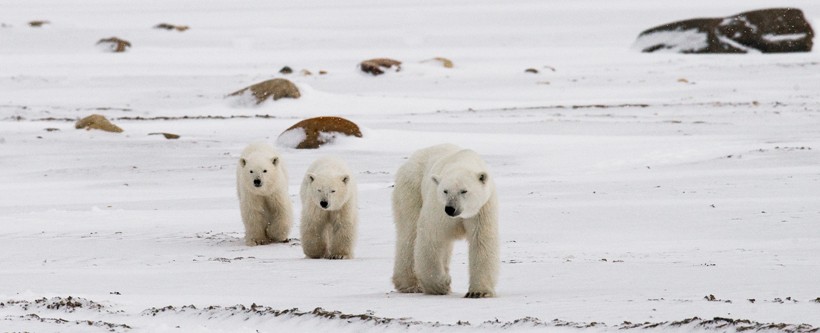
Polar bear walking with cubs over the tundra of Canada
?
Image credits: GUDKOV ANDREY/Shutterstock
Cubs are 12 to 14 in (30-35 cm) long and weigh about one pound (0.5 kg). They are born with light brown fur and are blind. The cubs drink their mothers' fat-rich milk and gain 20-30 pounds before leaving their dens in March or April.
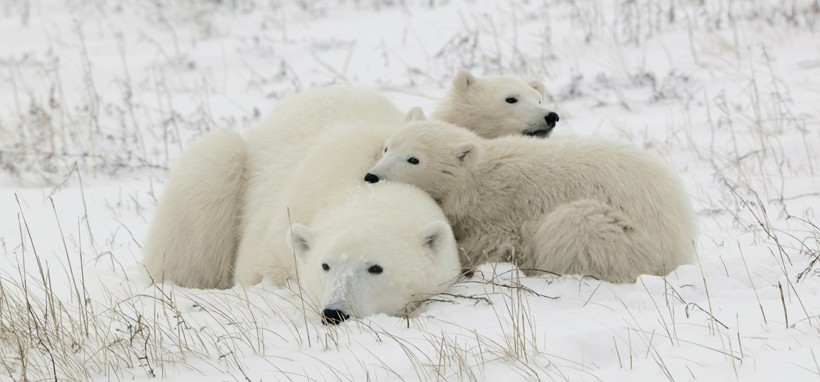
Young ones remain with their mothers for about two years.
?
Image credits: Sergey Uryadnikov/Shutterstock
Young ones remain with their mothers for about two years. During this period, the cubs imitate their mothers, play, walk, learn hunting skills and prepare themselves for the life ahead. It is the responsibility of the female to rear the offspring. They nurture and protect the little ones. Male polar bears leave the females once the mating is over.
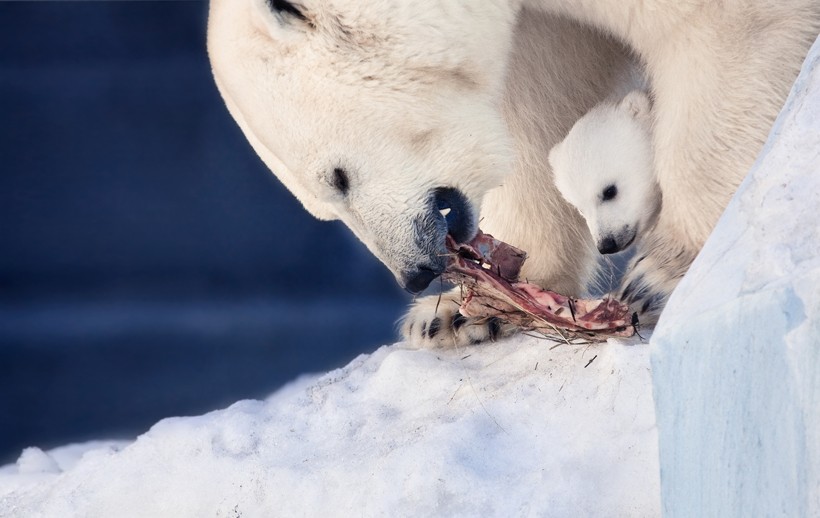
In those two years, the cub learns hunting skills from the mother
?
Image credits: Shvaygert Ekaterina/Shutterstock
Polar bears live up to 25-30 years. There is limited information on the causes of death. It is believed that they become too old and weak to catch prey in sufficient volumes with starvation and dying as the consequence. Additionally, some of them die because of injuries as incurred during fights or accidents.
Brown bears and polar bears are genetically compatible and can produce fertile offspring. In 2006, a hybrid of the polar bear and a grizzly was observed in the Canadian Arctic. "Pizzly", as some call it, proved that grizzly and polar bears can interbreed.
Behavior, Communication and Intelligence
The adorable polar bears are both solo players as well as social animals. They typically live a solitary life and prefer company only for mating. However, some polar bears have been seen playing together, especially the cubs are cute playful creatures. Play-fighting among the young polar bears helps to prepare them for mating competitions.
Although not extremely territorial, polar bears are said to be aggressive. They are very cautious during confrontations and handling a safe mode of escaping a dangerous situation rather than fighting. Only upon provoking they attack human beings. Since they are exposed to limited human interactions, polar bears are highly unpredictable. Therefore, an attack on human beings may result in a fatal killing. The defence of polar bears differs from brown bears. While brown bears maul and leave the human being afterwards, polar bears attack in a predatory manner, often resulting in a killing.
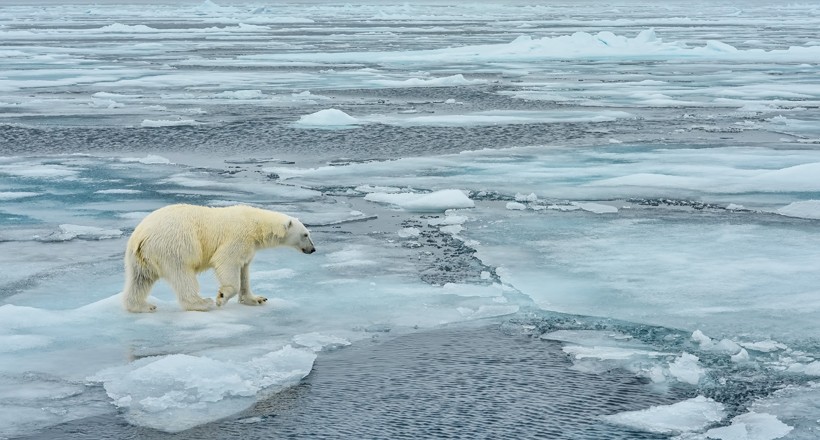
Polar bear walking across the arctic ice floe
?
Image credits: FloridaStock/Shutterstock
Adult male polar bears walk with an average speed of about 6 km/h (3 mph) while that of a female with cubs is about 4 km/h (2.5 mph). They are known for their slow gait. Although they can gallop like horses, they prefer leisurely walks. Scientists believe that polar bears require more than twice the energy used by other mammals while running or walking.
Polar bears can generate a top speed of around 40 km/h (25 mph) although only for small time intervals. Younger bears run faster than the older ones and may run for about two kilometers without taking a break.
These lovely creatures are pretty hygiene-conscious. They keep themselves clean and dry. A wet fur is not a good insulator and it is, therefore, essential to maintain a dry coat. During summer, they eat for about 30 minutes and then wash themselves off for about 15 minutes. They dry themselves by shaking the water off and rubbing their bodies in the snow.
During winter, the cuddly cub bears keep themselves clean by rubbing their bodies in the snow. Adults regularly swim in ice openings. They rub their heads and tummies and roll their backs in the snow. The mother licks also her cubs to keep them clean.
Their sleeping pattern is similar to that of human beings. They sleep for about 7-8 hours and also take short naps. Polar bears can take a nap almost anytime and anywhere. To relax after a hearty meal of seals, they doze off to conserve energy.
Unlike brown bears, polar bears do not hibernate in winters with the exception of the pregnant females. Adult males and non-pregnant females are active throughout the year.
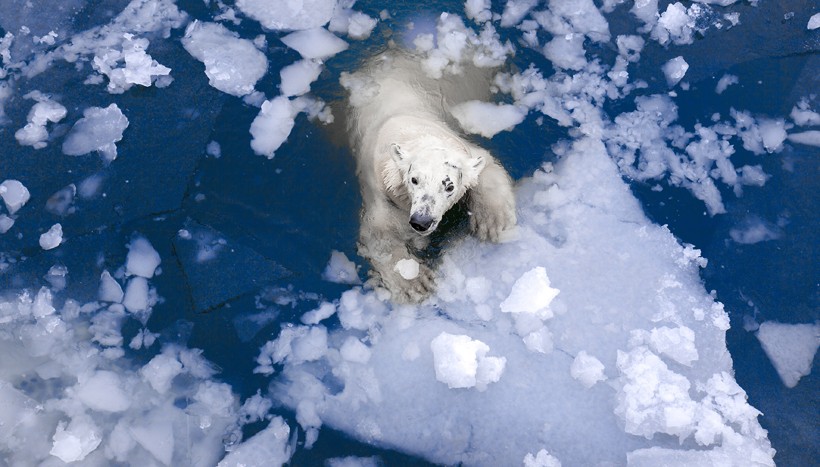
Polar bears can swim up to 350 km (220 m) in one run
?
Image credits: Baranov E/Shutterstock
Polar bears are very good swimmers. Studies suggest that they may swim up to 350 km (220 m) in one run with an average speed of 10 km/h (6 mph). They are also able to dive under water for a period up to three minutes. This strategy is used to attack seals present on the shore or on the ice.
Communication among polar bears occurs through body language, scent communication and vocalizations. Different communication possibilities have been identified:
- Nose greetings: To ask for something such as food
- Sideway head wagging: To initiate play
- Scent communication: To motivate reproductive interest
- Head down and ears back: To attack
- Loud roars: To communicate anger
- Chuffing: To respond to stress
- Hissing and snorting: To display aggression
- Deep growls: To warn
Population and Conservation Status
The 2015 reports of the International Union of Conservation of Nature (IUCN) suggest that there are about 31,000 polar bears present globally. The accurate number cannot be estimated because of their remote home ranges. These amazing mammals are listed under "Vulnerable" species as there is a significant decline in the number of polar bears.
As mentioned earlier, polar bears form an integral part of the Arctic ecosystem and provide us with a critical understanding of the Arctic. A risk for polar bears means also a risk for the total Arctic marine ecosystem.
One of the major threats faced by polar bears is climate change. Rising temperatures melt the sea ice earlier than the natural schedule. As a result, polar bears are unable to collect enough food by means of hunting seals that resides temporarily on this sea ice. This leads to acute starvation and eventual death. Reduced sea ice forces polar bears to swim longer distances and many of them drown due to depletion of their energy reserves.
Polar bears are at the top of the food chain and consume huge amounts of blubber that contain halocarbons - a highly toxic chemical. That's why polar bears are believed to be the most contaminated animals of the region.
The habitat of polar bears contains oil and gas reserves, exploited by mankind. An oil spill can prove catastrophic to polar bears as well as other animals. Polar bears tend to lick the oil off their furs, what may lead to kidney failure.
The five polar bear nations, the United States, Canada, Norway, Russia and Greenland are making efforts to conserve these adorable animals. Measures such as United States Marine Mammal Protection Act, The International Agreement on Conservation of Polar Bears and their Habitat, The Endangered Species Act, and Convention on International Trade in Endangered Species of Wild Fauna and Flora are taken to protect polar bears.
Cultural Depictions
Nanuq, or polar bears, are the most honored animals hunted by indigenous people. In some parts of the Arctic, indigenous people hunt polar bears as part of their cultural traditions. The meat of polar bears is eaten while the fur is used for clothing and boots. The liver of polar bears is the only body part that is not eaten as it contains high levels of Vitamin A that can be fatal for human beings. Nowadays, various agencies carefully regulate these hunts in order to prevent extinction.
As per a certain legend, some natives believe that polar bears are actually human beings that come out wearing the bear skin. Once they are at home, the polar bear-men shed off their skin.
To honor the spirit of polar bears, natives would place the polar bear's skin at a special place in their homes.
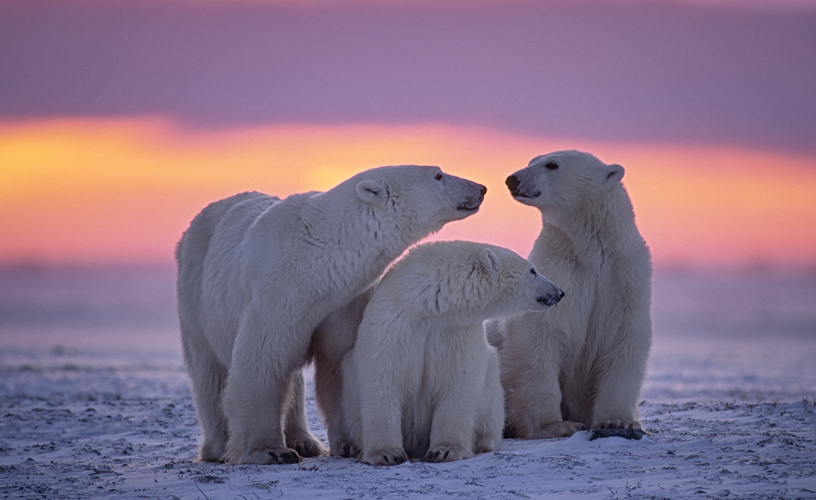
The Polar bear has been the Winter Olympic mascot twice
?
Image credits: outdoorsman/Shutterstock
Natives believe that the canine teeth of polar bears possess talismanic power. They are selling these teeth within their villages. People are placing these magical teeth on their hats to protect themselves from brown bears.
People from the Siberian tribe Ket, call polar bears “gyp” which means grandfather and “qoi” which means stepfather. The Sámi people of the Arctic are mindful not to offend the cuddly creatures. That's why they never use the real name but call them “old man in the fur cloak” or ”God's dog”. Because of their slow and in-toe gait, polar bears were also referred to as the farmer by the nineteenth-century whalers.
Polar bears also feature many works of fiction and folklore such as The Polar Bear Son, Noah's Island and East. The cuddly animals are popular icons too, especially at places where they have been found. But that's not all! Polar bears also endorse many brands such as Polar Beverages, Good Humor-Breyers and Coca-Cola.
Evolutionary History
Polar bears are a relatively new species. Scientists believe that polar bears evolved from brown bears and developed specializations to inhabit the harsh Arctic. According to fossils found, the emergence of polar bears may have taken place about 110,000 years ago.
Based on available fossils, scientists were able to identify the polar bear evolution pathway. Around 125,000 years ago when the Arctic ocean was frozen, a population of brown bears drifted away from their ancestors, possibly in search of food. While most of the population might have died in the harsh environment, some bears survived and bred. They had the evolutionary advantage of a thick, white coat. Over thousands of years, the surviving bears underwent more evolutionary changes and adapted themselves to survive the extreme polar environment. Gradually, they began hunting seals which was an important step in their evolution.
Funfacts
- The size of the largest polar bear ever recorded was 3.7 m (12 ft) and weighted 1,002 kg (2,209 lb).
- Their fur consists of water repellant hair that prevents entanglement when wet.
- Polar bears are the largest carnivores of the bear family.
- The Polar bear has been the Winter Olympic mascot twice.
- Stomachs of polar bears can hold a lot of weight, around 150 lb.
